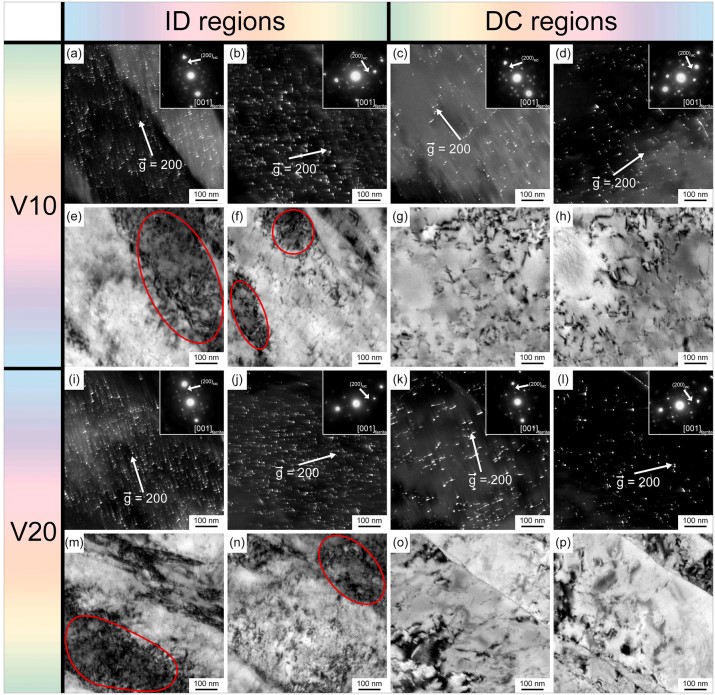
许多具有两种变体的纳米级MC碳化物在TEM暗场图像中作为暗背景上的明亮颗粒出现。随机分散在基体中的MC碳化物的微椭圆形形态几乎相同,因为它们沿着(200)惯习面生长,然而,与枝晶间区域相比,在枝晶干区域成核的MC碳化物倾向于平行于每个变体中的 (200) 个惯习面。另一方面,与枝晶干区域相比,在枝晶间区域的每个TEM明场图像中观察到由马氏体相变引起的显着高密度的纠缠位错,如图(红色圆圈)所示。从马氏体转变中继承的相当高密度的位错与枝晶间区强碳化物形成元素(V 和 Mo)的富集之间的协同效应促进了 MC 碳化物比枝晶干区更高的成核率。据信,MC 碳化物和位错通过 MC 在位错上成核或通过 MC 碳化物钉扎位错而相互作用。由更多的 MC 碳化物导致的钉扎现象增加也可能是导致 ID 区域更高的位错密度的重要因素。
Numerous nano-scale MC carbides with double variants appear in the TEM DF images as bright particles on a dark background. The slightly ellipsoid-shaped morphology of MC carbides randomly dispersed in the matrix was nearly identical because they grew along with the (200) habit plane, however, comparing with ID region, the MC carbides nucleated at DC region tended to be more elongated parallel to the (200) habit plane in each variant. On the other hand, entangled dislocations of a significantly high density resulting from martensitic phase transformation are observed in each of the TEM BF images at ID region, in comparison with DC region, as shown in Fig (red circles). The synergistic effect between a considerably high density of dislocations inherited from the martensitic transformation and the enrichment of strong carbide forming elements (V and Mo) at ID region promoted a higher nucleation rate of the MC carbides than those at DC region. It is believed that MC carbides and dislocations interacted by either MC nucleating on dislocations or through MC carbides pinning dislocations. The increased pinning phenomenon resulting from more MC carbides was also likely an important contributor to the higher dislocation densities at ID region.